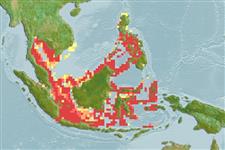Actinopterygii (ray-finned fishes) >
Clupeiformes (Herrings) >
Clupeidae (Herrings, shads, sardines, menhadens) > Dorosomatinae
Etymology: Herklotsichthys: After Janus Adrian Herklots, Australian ichthyologist, 1820-1872.
Environment / Climate / Range
Ecology
Marine; brackish; pelagic-neritic; depth range 0 - 50 m (Ref. 188). Tropical, preferred ?; 20°N - 9°S, 98°E - 129°E (Ref. 188)
Western Central Pacific: Gulf of Thailand, Philippines, and Indonesia.
Size / Weight / Age
Maturity: Lm ? range ? - ? cm
Max length : 8.5 cm SL male/unsexed; (Ref. 188); common length : 7.0 cm SL male/unsexed; (Ref. 188)
Dorsal
spines
(total): 0;
Dorsal
soft rays
(total): 13-21;
Anal
spines: 0;
Anal
soft rays: 12 - 23. Immediately distinguished from all other species of Herklotsichthys by the presence of two dark saddle-like blotches on the back, at the hind part of the dorsal fin base and a short distance behind this. Overlaps range of H. quadrimaculatus, which lacks the black saddles and has elongate wing-like scales underneath the normal paired pre-dorsal scales.
A schooling species found in coastal waters. Uncommon.
Life cycle and mating behavior
Maturity | Reproduction | Spawning | Eggs | Fecundity | Larvae
Whitehead, P.J.P., 1985. FAO Species Catalogue. Vol. 7. Clupeoid fishes of the world (suborder Clupeioidei). An annotated and illustrated catalogue of the herrings, sardines, pilchards, sprats, shads, anchovies and wolf-herrings. FAO Fish. Synop. 125(7/1):1-303. Rome: FAO. (Ref. 188)
IUCN Red List Status (Ref. 115185)
CITES (Ref. 94142)
Not Evaluated
Threat to humans
Harmless
Human uses
Fisheries: subsistence fisheries
More information
ReferencesAquacultureAquaculture profileStrainsGeneticsAllele frequenciesHeritabilityDiseasesProcessingMass conversion
Tools
Special reports
Download XML
Internet sources
